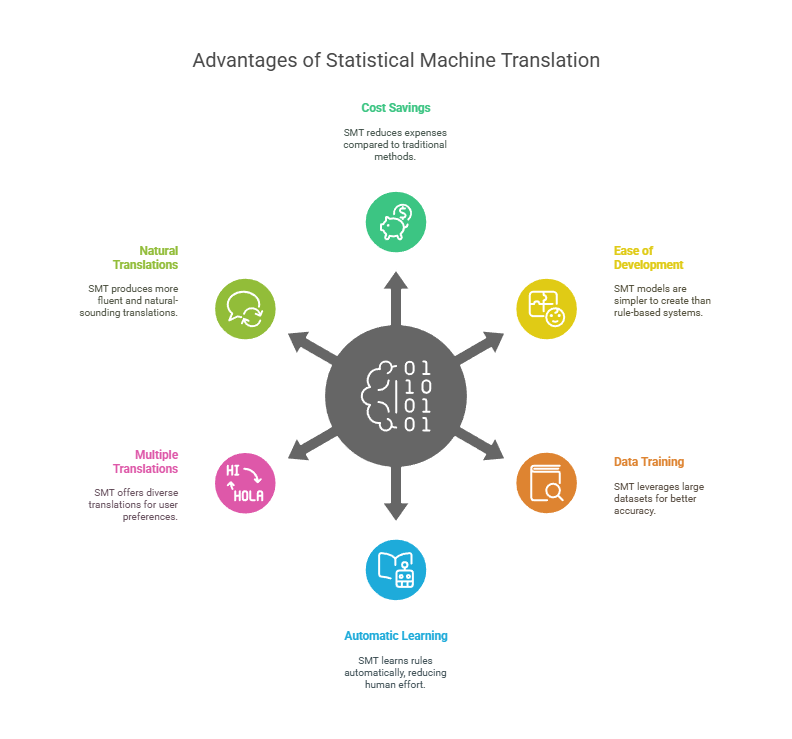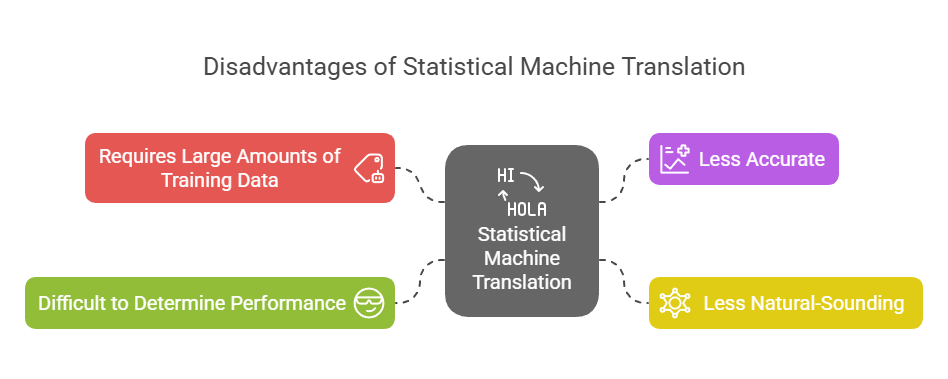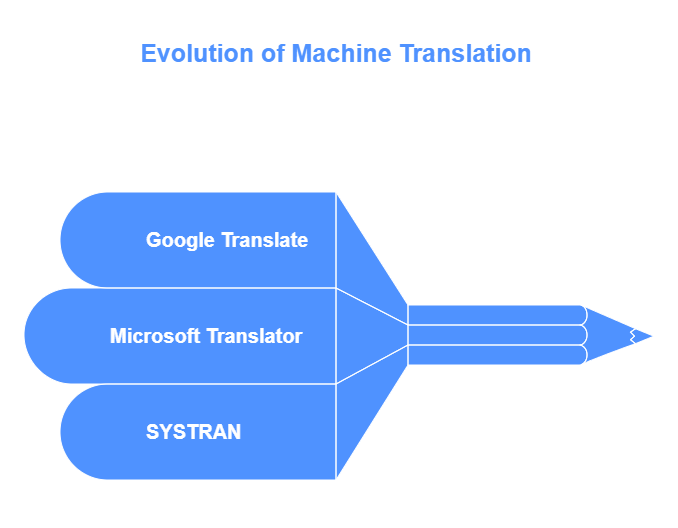Discover the Disadvantages Of SMT, including its struggle with incorporating linguistic knowledge and the high computational cost associated with training and running models.”
What is statistical machine translation?
Statistical machine translation (SMT) is a branch of that translates text across natural languages using mathematical models. SMT examines previous sets of translations in the language pair, referred to as text corpora. This makes it possible for the system to calculate the likelihood of an outcome. The translation with the best chance of correctness is then selected.
The majority of sectors have switched to neural translation systems since 2014. A hybrid technique that combines SMT and NMT, however, improves accuracy, according to several studies. In agreement, some language service providers employ hybrid systems as an extra measure to ensure quality.
Statistical machine translation approaches
When SMT was initially developed in 1990, it was seen to be a significant advance over the conventional rules-based translation method. To overcome the obstacles, researchers improved the initial models. Numerous statistical translation methodologies emerged as a result of their work.
Word-Based Statistical Machine Translation
The word-based method is straightforward; it generates words one at a time. But it has a number of drawbacks. Because it ignores the sentence’s grammatical structure and the word’s context, translations may become haphazard and alter the original text’s meaning.
Conventional Phrase-Based Statistical Machine Translation
The model interprets word sequences. This method is more intricate and gets around the drawbacks of the word-based method. The sense of the original text is preserved in the translation by analysing the sentence’s grammatical structure and context. But phrase-based methods don’t sound as natural.
Syntax-Based Statistical Translation
Fluency is enhanced by the model’s translation of syntactic components. These translations seem more natural than the phrase-based method since it can understand certain phrase turns.
Hierarchical phrase-based translation (HPBT)
The machine translation technique known as HPBT makes use of both a hierarchical language model and a phrase-based translation model. This model is the most often used for capturing the syntactic and semantic connections between words in a sentence using probability.
Machine translation, information retrieval, and question answering are just a few of the tasks on which the HPBT technique has shown superior to traditional phrase-based translation models. In recent years, the fundamental idea of HPBT has been expanded to include computer vision and natural language processing.
Advantages of SMT

Comparing statistical machine translation to conventional rule-based machine translation techniques reveals several benefits.
Saves Businesses Money
SMT is faster and cheaper than rules-based or human translation. Competitive IT, medical, IT, and e-commerce firms must save time and money.
Easier To Develop SMT Models
Rules-based systems need rules for every language, and collecting grammatical rules and building extensive dictionaries are challenging tasks. Therefore, designing statistical models for several languages takes less time and effort than creating distinct rule-based systems for each language.
Training With Large Data
A vast volume of translated texts may be used to train the models since statistical machine translation uses a lot more data than conventional techniques. Since such data is the sole resource accessible for low-resource languages, this is particularly crucial.
Automatic Learning
Third, instead of needing to be explicitly stated by professionals, the translation rules may be automatically learnt from data using statistical approaches. This eliminates the need for costly human knowledge and enables quick adaptation of the translation system to incorporate additional languages or areas.
Generates Multiple Translations
In applications like information retrieval, where users may have varying preferences, SMT systems’ ability to produce several translations for a given input might be helpful.
More Fluent, Natural-Sounding Translations
Translations using statistical machine translation can sound more natural and fluid than those from conventional rule-based techniques.
Disadvantages Of SMT

Requires Large Amounts Of Training Data
Due to the need for more intricate algorithms and more training datasets, SMT may be slower and need more resources than NMT. SMT is a sophisticated system that is challenging to comprehend and troubleshoot.
At the same time, NMT is quicker and requires less training. For instance, Google just unveiled Zero-Shot Translation, a system that can translate text without the need for any kind of training on language pairings.
Less Accurate
Initially, SMT frequently depends on statistical techniques, which may not be as precise as the neural networks employed in NMT. Neural networks are more sensitive to context and subtleties since they process languages in a manner like to that of the human brain’s word decoding.
Less Natural-Sounding Than NMT
Adapting SMT to new languages and topics is more challenging since it depends on particular rules or patterns that might not generalise adequately. Anybody who has studied a language is aware that every rule has exceptions. Translations that don’t sound natural may thus be the result of this rigorous adherence to the guidelines.
Difficult To Determine How Well SMT Will Perform
Lastly, it is frequently challenging to provide a confidence estimate for SMT machine translation as these systems mostly depend on probabilities.
Statistical Machine Translation Examples

Google Translate
In 2006, Google started out as a statistical machine translation service. These days, it offers translation services using neural machines in more than 133 languages.
Microsoft Translator
Microsoft Translator’s previous iterations serve as instances of statistical machine translation. It currently employs neural machine translation, just like a lot of other machine translation software firms. It is a component of Cognitive Services on Azure.
SYSTRAN
SYSTRAN was among the first businesses to provide statistical machine translation services online. Its commercial machine translation software bundle contains several text translation capabilities.
